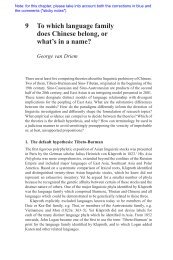1 Austronesian cultural origins
1 Austronesian cultural origins
1 Austronesian cultural origins
You also want an ePaper? Increase the reach of your titles
YUMPU automatically turns print PDFs into web optimized ePapers that Google loves.
28 Peter Bellwood and Eusebio Dizon<br />
As discussed elsewhere (Bellwood et al. 2003: 142), there was never a<br />
Pleistocene land bridge from Taiwan to Luzon via the Batanes because the<br />
intervening sea passages are too deep. So it comes as no surprise that, during<br />
four seasons of archaeological fieldwork in the Batanes, excavations in six caves<br />
and rock shelters (amongst other sites) have failed absolutely to give any sign of<br />
pre‑ceramic occupation. All sites are sterile <strong>cultural</strong>ly below the lowest potsherds,<br />
and the islands have no trace of a pre‑ceramic lithic industry. The Batanes were<br />
seemingly first settled by Neolithic populations moving from Taiwan with pottery,<br />
polished stone and developed maritime technologies, presumably the ancestors of<br />
the present Ivatan and Itbayaten populations.<br />
This circumstance means that the Batanes have a very different kind of<br />
prehistory from, for instance, Luzon, or other islands in the Philippines and<br />
Indonesia where there were Pleistocene populations of hunter‑gatherers using<br />
flaked lithics. In the Cagayan Valley on Luzon we have an interesting situation<br />
of interaction between incoming Neolithic and presumed indigenous hunter‑<br />
gatherer populations. Archaeology reveals the roots of this interaction, because<br />
a hunter‑gatherer (presumably ancestral Agta) human presence is attested in the<br />
Peñablanca Caves in the Cagayan Valley from at least 25,000 bp (Mijares 2005). In<br />
the Batanes, however, Neolithic populations arrived to find an apparently pristine<br />
landscape untouched by humans, as did the first <strong>Austronesian</strong>s to enter Remote<br />
Oceania several centuries later.<br />
As far as Batanes Neolithic archaeology is concerned, we now have a number<br />
of sites dating from about 4000 years ago and onwards, the older ones revealing<br />
some rather surprising connections with Taiwan. Because the Batanes <strong>cultural</strong><br />
sequence has been discussed in some detail elsewhere (Bellwood et al. 2003;<br />
Bellwood and Dizon 2005), we only refer here to the four most significant sites<br />
that illustrate initial settlement from Taiwan, followed by continuing contacts<br />
afterwards for almost three millennia.<br />
Torongan and Reranum Caves, Itbayat Island<br />
The oldest assemblages known so far in the Batanes come from the interior of<br />
the Torongan sea cave on the east coast of Itbayat, and from Reranum Cave at<br />
the northern tip of the island. Torongan is about 100 m long, and was probably<br />
of great significance because it allowed access out to the sea from the interior<br />
of the island (the coastal cliffs here rise sheer about 80 m above the sea). The<br />
archaeological deposit is located about 13 m above the base of the cave, near the<br />
top of a high cone of fallen rock and soil piled against the south‑western wall of<br />
the inland mouth. The basal horizon contained sherds of plain and red‑slipped<br />
pottery, otherwise undecorated, with everted and slightly concave rims paralleled<br />
closely in the site of Chaolaiqiao in south‑eastern Taiwan (Figure 1.1). Reranum<br />
Cave, only excavated in 2006, has very similar pottery, together with a few fine<br />
cord‑marked sherds, and we are still awaiting dates for this site. Chaolaiqiao,<br />
securely dated by AMS C 14 to 2200 bc, is a very important discovery because<br />
it establishes the presence of this horizon of predominantly red‑slipped pottery



